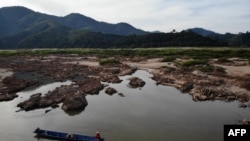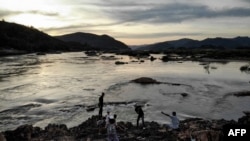Mainland Southeast Asia is entering its fourth year of drought, with climate change and unrelenting dam construction taking an unprecedented toll on the Mekong River and the 65 million people who rely on the waterway for their livelihoods.
In Cambodia, the drought has prompted a government call to use water sparingly, particularly in rural areas, saying rainfall from the recent wet season “will not be enough to meet the immediate needs,” and a separate report adding water capacity for irrigation is operating at just 20%.
The Ministry of Water Resources also said in a recent statement that lower rainfall was predicted for this – after three years of record lows resulted in the worst river conditions for more than 60 years, punishing agricultural output and livelihoods.
In response, the Mekong River Commission has called for a bold action plan from its six members – Cambodia, Laos, Myanmar, Thailand, Vietnam and China – to address the major issues confronting Southeast Asia’s major waterway.
It wants immediate steps “to mitigate the crisis.” These include establishing a joint notification mechanism on unusual water level fluctuations and, in the future, coordinated operation and management of reservoirs and hydropower dams.
“In addition, the countries should examine options to build more storage to manage pressing drought and flood conditions as well as an operational model for the whole Mekong Basin,” said An Pich Hatda, chief executive officer of the MRC Secretariat.
However, analysts said the perennial problems of the past two decades continue to plague the river amid a drought made worse by climate change and a failure to coordinate.
“It’s very difficult at the moment to get an overall picture of just what’s happening. So much of what’s coming out about the Mekong has just been anecdotal,” said Milton Osborne, a historian who has closely monitored the river system for more than 20 years.
“It’s only 40 years since the river was running free and without any sort of impediment,” he said.
“Now you’ve got 11-plus dams in China, you’ve got the dams being built in Laos and all of the discussion that took place 10 years ago about how this was going to be a negative impact on the Mekong seems to be just not addressed in the material being put out by the MRC.”
According to the U.S.-based Stimson Center, 11 dams that block the main stream of the Mekong River in China and Laos have been completed. A further 118 dams have been built along its tributaries.
There are also hundreds of smaller dams used for irrigation, cultivating crops, harvesting fish and water distribution across the lower Mekong countries.
Those dams are also holding back 50% of sediment, which combined with sand dredging and a lack of water levels required to flush the river clean, has raised salinity levels.
Farmers in southern Vietnam’s Ben Tre province say the lower Mekong Delta is now salty for up to four months instead of the usual one month of the year, and entire fields of trees are are being killed by saltwater intrusion.
“It makes one think the Mekong is well past it’s point of no return. There’s an important need to focus on tributary dams and their impacts since there are so many,” said Brian Eyler, director of the Stimson Center’s Southeast Asia Program.
In its latest report, Mekong Low Flow and Drought Conditions in 2019-21, the MRC found the “hydrological regime” had changed significantly since 2015, with more water flowing in the dry season months and less in the wet season due to increased storage.
In particular, the 100-page report highlighted the Tonle Sap Lake, a tributary of the Mekong which fills up each wet season and, once filled, reverses direction back into the Mekong River and then out to the South China Sea.
An important bellwether of the wider basin’s hydrology, Tonle Sap water levels were close to average in 2019 but levels in 2020 and 2021 were the lowest on record, the report said.
Total reverse flows in 2020 and 2021 were 58% and 51% respectively of the average total reverse flow volume measured from 2008 to 2021, it said. Much of that has been blamed on water hoarding by hydroelectric dams in China and Laos.
“They were taking water out of the system during the wet season, they’re putting it back in the dry season and letting it flow downstream right out into the ocean and it has no useful purpose in the dry season because the level of the river is still too low to make a difference,” Eyler said.
According to the MRC report, 2020 was the driest year, with rainfall was below normal levels in every month except October, and more action was required “not just from China but from all the MRC member countries to jointly address these issues.”
The immediate outlook has not improved for the lower Mekong region, where economies have already been crushed by the COVID-19 pandemic.
“Going into this next dry season, the conditions for agricultural production are extremely dismal because of a lack of fresh water throughout the basin, particularly in the floodplain around the Tonle Sap and in the Mekong Delta,” Eyler said.
“So the coming five months will be a repeat performance of the previous three dry seasons, if not worse,” he added.






